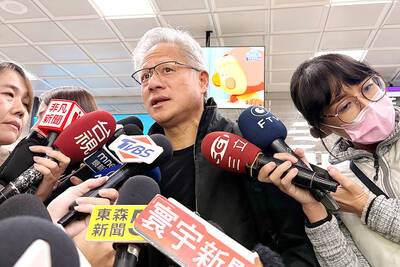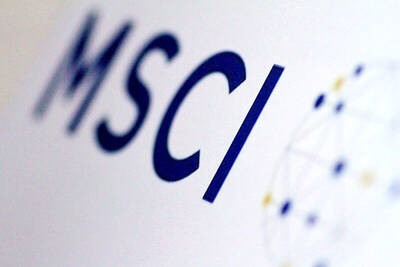Swelling disposable incomes, a discernible shift in taste and a company shake-up has left Vietnam's leading wine producer licking its lips in anticipation of an expected sales boom.
Since it first began specializing in making wine in 1993, the Hanoi-based Thang Long Co has seen its profits rise from around US$200,000 to a respectable US$1.3 million last year from revenue of US$4.25 million.

PHOTO: AFP
Ngan Pham-bang, the company's general director, expects profit margins to rise exponentially after its equitization or semi-privatization which began in 2000 but was only completed mid-way through last year.
It is just one of 861 companies from the more than 5,600 state-owned enterprises that have sold off stock in themselves in a bid to raise capital and improve efficiency since the equitization process kicked off in 1995.
In Thang Long's case, the government has retained a 40 percent stake, domestic investors have snapped up 20 percent, while its 300 staff and management hold the balance.
"This has had a big effect on the company now that everyone owes some capital because staff are more proactive," Ngan said. "Even I have to work harder and continually strive to improve the company's performance or else someone will replace me. I have to ensure that shareholder value grows."
Surprisingly, he says sales growth for the most bourgeois of tipples lies with Vietnam's lower-middle classes, despite GDP per capita in the communist-ruled country hovering at US$430.
"The upper-middle classes aspire to drink imported wine, but more and more people in the countryside and among the urban lower-middle classes are changing from drinking rice wine at weddings and other celebrations to fruit-based wine."
Ngan attributes the phenomenon to the ripple effects of Vietnam's gradual transition to a socialist-leaning market economy, which has boosted personal wealth levels in the major cities.
The wine's sweet, but highly palatable taste, and the fact that at less than one dollar a bottle, it costs almost the same as the best quality rice wine, are encouraging people to make the switch, he said.
However, unlike its French, Australian, Chilean or even Japanese elder cousins, the majority of Vietnamese wine is not made from grapes, though it is not for lack of trying. Strawberries, pineapples, apricots and a local speciality, tao meo or wild apples grown in isolated, mountainous northern areas, are the usual ingredients.
"The truth is, we really want to produce grape wine but Vietnam does not have the expertise nor grapes of sufficient quality to make it," Ngan said.
Less than three percent of the five million litres produced by the company last year was made from grapes grown in Ninh Thuan province, but even he admitted it was of poor quality.
"We also tried importing grapes from other countries, but because we are not suitably skilled and our equipment is not advanced enough the project was not a success."
In a bid to keep its neck out in front of the 20 or so other state-run producers, Thang Long has been buying vats of wine from overseas during the past year and bottling it for sale in the domestic market.
Ngan said he was in contact with Western producers for help in expanding production of grape-based wine, but added that no one has yet agreed to invest the time and money needed to take the company to the next stage level.
He maintains that producing exotic fruit wine has its merits.
"Our work has brought many benefits to the Vietnamese people because we are using domestic resources by buying fruits from farmers, especially from those in the poor mountainous regions in the north.
"We are helping the government in its poverty reduction policies and we are also raising cultural education levels in rural areas."

PERSISTENT RUMORS: Nvidia’s CEO said the firm is not in talks to sell AI chips to China, but he would welcome a change in US policy barring the activity Nvidia Corp CEO Jensen Huang (黃仁勳) said his company is not in discussions to sell its Blackwell artificial intelligence (AI) chips to Chinese firms, waving off speculation it is trying to engineer a return to the world’s largest semiconductor market. Huang, who arrived in Taiwan yesterday ahead of meetings with longtime partner Taiwan Semiconductor Manufacturing Co (TSMC, 台積電), took the opportunity to clarify recent comments about the US-China AI race. The Nvidia head caused a stir in an interview this week with the Financial Times, in which he was quoted as saying “China will win” the AI race. Huang yesterday said

Nissan Motor Co has agreed to sell its global headquarters in Yokohama for ¥97 billion (US$630 million) to a group sponsored by Taiwanese autoparts maker Minth Group (敏實集團), as the struggling automaker seeks to shore up its financial position. The acquisition is led by a special purchase company managed by KJR Management Ltd, a Japanese real-estate unit of private equity giant KKR & Co, people familiar with the matter said. KJR said it would act as asset manager together with Mizuho Real Estate Management Co. Nissan is undergoing a broad cost-cutting campaign by eliminating jobs and shuttering plants as it grapples

The Chinese government has issued guidance requiring new data center projects that have received any state funds to only use domestically made artificial intelligence (AI) chips, two sources familiar with the matter told Reuters. In recent weeks, Chinese regulatory authorities have ordered such data centers that are less than 30 percent complete to remove all installed foreign chips, or cancel plans to purchase them, while projects in a more advanced stage would be decided on a case-by-case basis, the sources said. The move could represent one of China’s most aggressive steps yet to eliminate foreign technology from its critical infrastructure amid a

MORE WEIGHT: The national weighting was raised in one index while holding steady in two others, while several companies rose or fell in prominence MSCI Inc, a global index provider, has raised Taiwan’s weighting in one of its major indices and left the country’s weighting unchanged in two other indices after a regular index review. In a statement released on Thursday, MSCI said it has upgraded Taiwan’s weighting in the MSCI All-Country World Index by 0.02 percentage points to 2.25 percent, while maintaining the weighting in the MSCI Emerging Markets Index, the most closely watched by foreign institutional investors, at 20.46 percent. Additionally, the index provider has left Taiwan’s weighting in the MSCI All-Country Asia ex-Japan Index unchanged at 23.15 percent. The latest index adjustments are to